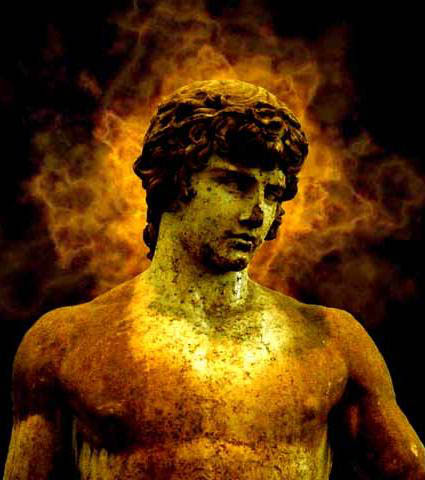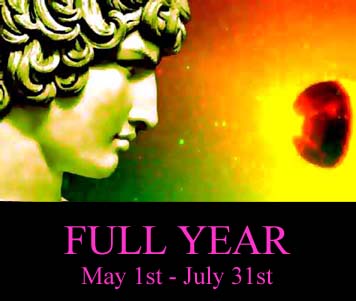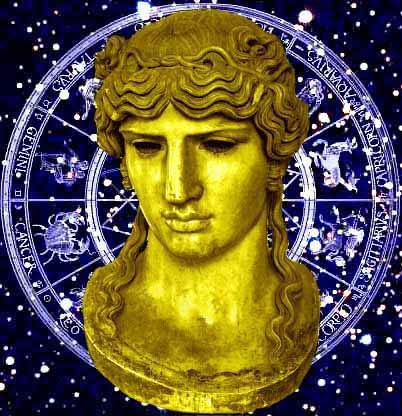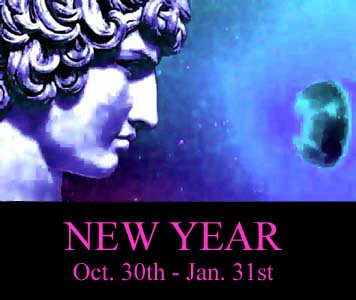
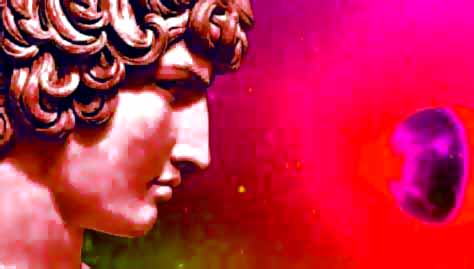
LITURGICAL CALENDAR
PART IV
The Last Quarter
August 1st - October 29th
AUGUST
1- The Departure from Tibur (Per. An. I)
The three-year Sacred Calendar begins, known as the Peregrinatio ad Orientem, which follows the progress of Hadrian and Antinous on their Tour of the East. The inner circle of Hadrian departs from the Villa at Tibur with solemnity and with prayers to Mercury the god of travelers. The Villa at Tibur is regarded as the second most sacred city after Antinoopolis because it was here that Hadrian and Antinous lived together for most of their relationship, it was from here that Hadrian would later disseminate the religion of Antinous, and it is believed that the tomb of Antinous may be located in an unexcavated corner of the vast ruins. As they depart, Antinous is the acknowledged favorite of Hadrian. This is the last moment that Antinous spent in the West, and is observed in solemnity as the departure of Antinous from the repression of Rome to the loving embrace of Greece. The fall of the ancient religion and the destruction of the Holy City of Antinoopolis are mourned, as the meaning of the departure is also the occasion where we remember the fall of his glorious religion, and the centuries of silence which have preceded our revival.
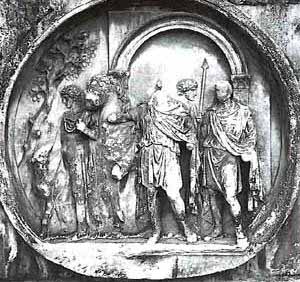
1- Antinous in Antioch (Per. An. II)
The court arrived at Antioch in August of 129, beginning the second year of the Peregrination. Antioch was to be the base of Imperial administration until early spring of 130. This prolonged stay was spent visiting the regions of Syria. Unlike the cities of Asia Minor, which opened their hearts to Hadrian and proclaimed him a living god, the people of Antioch were cold and critical of Hadrian's policies. The large Jewish population resisted the policies of Hellenization, which Hadrian promoted, they would not cooperate with the new religious order of unity, and condemned the whole effort as blasphemous. The Christians were equally seditious, and defiant. They were disgusted by the presence of Antinous by the side of the Emperor, and called the whole affair an abomination. Antioch was the center of Christianity in the ancient Roman world. It had been the base from which Paul the Apostle operated, and was considered to be his seat. It was from Antioch that Paul wrote the Epistle to the Romans that is now part of the Bible, which specifically forbids and condemns homosexuality, and thereby dictates the position of the Christian religion on same-sex love (a position never taken by Jesus.) Antioch represents the enemies of homosexuality as embodied by the Apostle Paul. It was here that Hadrian and Antinous first discovered that their love was considered to be unholy, a reality that was to over cloud the religion of Antinous and of same-sex love for centuries to come. We observe that when Antinous entered Antioch, the darkness of hatred for homosexuality was born. Our enemies in the Christian Church took inspiration from the beauty of Antinous and used his deification as a weapon for our destruction. It was in Antioch that homosexuality was crucified. We lament the misery brought against our kind, and we remember those countless souls who were brutalized and murdered for our cause, and for our form of Love. Through Antinous, upon whom the hatred of Antioch fell, we pray for salvation as we enter the second year of the Sacred Peregrination.

1- Antinous in Alexandria (Per. An. III)
The Imperial entourage entered Alexandria in the year 130, beginning the third year of the Peregrination. The people of the largest city in the Empire greeted Hadrian as Pharaoh and God in public celebrations. The Jewish and Christian community, as in Antioch, was not welcoming, being openly scornful of the divine honors lavished upon a man whom they considered immoral, due to the presence of Antinous. Alexandria was a city of diverse religious expression, it was also the home of the Museum and the restored library where Philosophers met to study, discuss, and debate the wide rage of philosophy. This difficult period spent in Alexandria is reverenced as the period in which the Gnostic Fathers came in contact with the ruler who had given them the freedom to resist Orthodoxy and set in motion their revolutionary doctrines, which would one day undo Christianity. The anxiety of the recent stay in Jerusalem, was alleviated in the Hellenic-Ptolemaic Alexandria, a city of admixture, wisdom and magic. The god of Alexandria is Serapis, who is a fusion of Zeus, Hades, Helios and Dionysus, with Osiris and the Apis Bull. The name of the Alexandrian god is from the Egyptian Osar-hapis. Hadrian was so moved by the religion of Serapis that he modeled the structures of the Villa known as the Canopus after the Temple of Serapis, which are believed to be an allegory of the Nile, Antinoopolis and the deification of Antinous. The god Serapis is the guardian of the freedom and expression of Alexandria, the devotion to knowledge, secret and scientific, which the library held. Serapis prepares Antinous for his journey up the Nile and cleanses the newly forming god of the taint of condemnation heaped upon him by the Jews and Christians. As the sacred star of Antinous nears its zenith in the night sky, Serapis unites Antinous with the immortal spirit of Alexander the God and his devoted Hepheistion. Thus we begin the third and final year of the Peregrination.
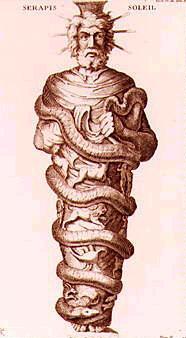
2- Antinous in Rome (Per. An. I)
Before leaving Rome, the Senate, Pontiffs, Flamenes, and all priesthoods, were summoned by Hadrian to the Pantheon, and there they conducted a solemn ceremony of benediction and safekeeping, for the benefit of the Emperor, for the City and for the World. With Antinous at his side, Hadrian announced his purpose for leaving Rome and journeying to the provinces. He enumerated his plan to improve the cities of the east, detailing his building projects, and the social, political reforms that would be enacted. Hadrian then made sacrifice to Jupiter Optimus Maximus, the ruler of Rome, while the Senate, in the name of Jupiter, blessed Hadrian and Antinous and the members of the court. Outside, the streets of the city were lined with people bidding farewell to their Emperor, who proceeded in a slow and grand procession. Antinous would have been prominently located near Hadrian as the procession left the sacred gates of the City. We pray to Our Lady Rome, mother of the world, to watch over us, and over civilization, her child, in time of danger, that the age of peace will come again.
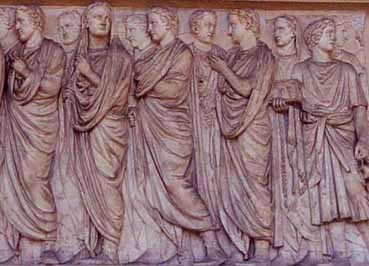
3- Antinous in Ostia (Per. An. I)
The Imperial Navy had gathered at the port of Ostia to escort Hadrian and the court across the sea to Greece. Ostia was the port city through which all trade bound for Rome passed. Sea going vessels were unloaded and their cargo was transferred to the riverboats that fed the ravenous gluttony of Rome. The patron god of Ostia was Vulcan, the smith god, seconded by Mercury who watched over the trade business. Vulcan was the son of Zeus and Hera, and he characterizes the molten earth fire of volcanoes. The tremendous power of Vulcan made him a suitable husband for Venus, but their love, through constructive and passionate was volatile and unpleasant. Venus was constantly betraying the adoration and fidelity of her husband with countless lovers, especially with Mars. But the love of Vulcan for his beautiful wife was greater than jealousy and he forgave her countless indiscretions. It is into Vulcan's hands, as intercessor and placator of Venus, that the hopes of the Imperial Navy rested as they departed from Italy. We pray to Vulcan, Mercury, Neptune and to Venus, Our Lady of the Sea, as Antinous journeys forth across the sea.

11- The Accession of Hadrian
While at Nikomedia, Capitol of Bythinia, Hadrian is declared Emperor by the legions upon the unexpected death of Trajan in the year 117. It is believed that the Empress Plotina, forged the will of her husband, naming Hadrian as successor. The support of the army insured the validity of our Emperor's claim, this is the beginning of the Sacred and Golden Age of the Antonines. Hadrian became Emperor over Rome at pinnacle of her glory. Her boundaries stretch farther than ever before; farther than they ever would again. Millions of people were subject to his authority. As Emperor, Hadrian first made peace with the Parthians, surrendering some of the land that Trajan had occupied, and then began the work of consolidating the Empire from the inside. We celebrate the Ascension of Hadrian as the miracle that might never have been, without which Antinous would never have been known, and our religion would never have been born. Hadrian is Our Father, Our Emperor and Our Capitoline God, we recognize on this day that the beginning of his age is the beginning of our own.
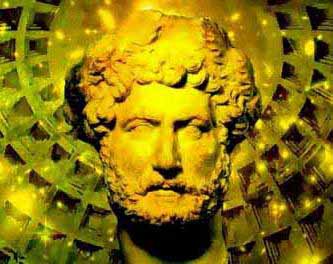
12- Hercules Invictus
The Great God Hercules, defender of mankind against chaos, the son of Zeus, the strongest and mightiest man that has ever lived, was one of the first of the Greek gods to be worshipped by the Romans. The Greeks of southern Italy introduced the Cult of Hercules at such an early date that the Romans were convinced that Hercules was indigenous, indeed he was admitted by Romulus into the sacred Pomeria, the spiritual protective wall of the city of Rome. The cult of Hercules was centered at Tibur, where Hadrian built his magnificent Villa, and Hadrian is often compared to Hercules for his travels, his physical strength, courage, and his sexual prowess. Hercules was driven mad by Hera and forced to murder his wife and children. In order to atone for his sin, he visited the oracle of Delphi and was instructed to submit to twelve labors. Hercules accomplished them all, and many others including the release of Prometheus from bondage. He was also a sexual champion and the number of his lovers is very long, and they include boys such as Abderus, Chonus, Haemon, Hylas, Iokastus, Iolaus, Nestor, Philoctetes, Polyphemus, Telamon, Abderus, Admetus, and Dryops. Without question, Hercules was a champion of homosexuality, and a defender of mankind against the forces of evil. For his benefit to mankind, he is venerated as a God and Protector of Ecclesia Antinoi.

13- The Birth of Diana
The Divine Huntress Diana was born on this day, according to the Lanuvium inscription which is consecrated to Antinous and Diana. She is said to be the twin sister of Apollo, but our belief is that the virgin huntress is the female Antinous, his twin sister, goddess of lesbian beauty just as Antinous is the god of gay beauty. Diana and Antinous are deities of the Moon. As Antinous is often assimilated to Apollo, he therefore substitutes as the twin of Diana, though he can often be viewed as her male double, so that Antinous is Diana. She is Helen of Troy to the Castor and Pollux of Antinous-Apollo, they share not only the attribute of hunters, and of the moon, but also as gods of magic and darkness. Diana is often compared to Heckate, the supreme goddess of Theurgian magicians, who rose to prominence during the reign of Marcus Aurelius. Antinous therefore is the male equivalent of Heckate. We pray to Diana to guide us in our hunt and to illuminate our nights with the silver light of her sublime power. We recognize that the Moon of Diana is the Moon of Antinous. On this night we venerate the Virgin, she who guides new life into the world, goddess of beasts, the mistress of the hounds, the archeress, the young Great Mother of Ephesus.
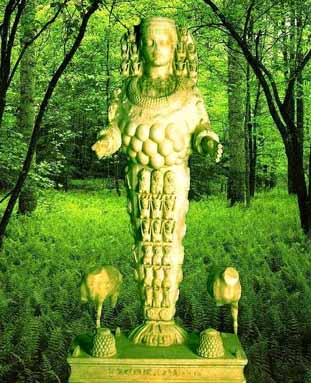
15- Antinous in Corinth (Per. An. I)
The Grand Imperial entourage arrived in Greece, at the city of Corinth in the late summer of 128. They visited the Temple of Fortuna, the goddess of fortune, known as Tyche to the Greeks. Hadrian and Antinous made sacrifice to her for the benefit of the tour and for the Empire as a whole. Fortuna, also known as Bona Dea, a manifestation of the Great Mother as a girl, in her aspect as the bestower of goodness, wealth and prosperity. Her consort was Agatho Daimon, the good Demon, pictured as a serpent. Antinous was later compared to Agatho Daimon, and is often pictured with the Serpent in his hand. The arrival of the court in the city of Corinth signaled the beginning of the association between Antinous-Agatho Daimon and his female counter-identity as Fortuna. We consecrate this day to our own fortune and to the forces of chance that play through our lives, as Hadrian and Antinous submitted their hope to the goddess at Corinth.
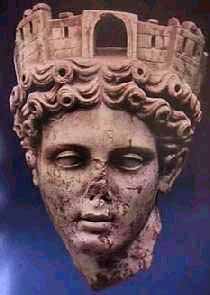
20- The Sacred Band
At the battle of Chaeronea in 338 B.C. King Phillip II of Macedonia and his son Alexander, later called The Great, defeated the combined forces of Athens and Thebes-Boetia. Alexander confronted the Sacred Band of Thebes, the elite corps of 300 homosexual lovers who were the most respected soldiers in the world at that time. When the Athenian and Theban armies gave way to the Macedonians and fled, the Sacred Band stood their ground and died. Only a few were subdued and captured. Of those that died, it was found that not one had been wounded in the back a sign that they had not turned away from the fight. Alexander was so moved by their nobility and courage that he asked his father to bury them with honor and raise a monument in the form of a lion over their graves. In 1881, the shattered fragments of this Lion were discovered, surrounded by the bones of 254 pairs of men with their weapons, arranged in a phalanx of seven rows, the battle formation of the Sacred Band. In 1902 the fragments of the Lion were reconstructed and placed again over the grave of the Sacred Band by the secret homosexual society known as the Order of Chaeronea, founded by George Cecil Ives. We consecrate and honor their memory and call upon their strength and courage in our own hearts, that we may become the New Sacred Band.
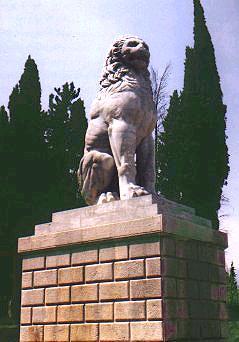
21- Antinous in Mantineia (Per. An. I)
The imperial court traveled through the Peloponnesus and visited the home of Antinous's ancestors in Arcadia, at the city of Mantineia. This is an important first event for Antinous as it represents his return to the place of the origin of his blood, which is the source of his mysterious name. Mantineia was to become the fourth most sacred city of the religion of Antinous, honoring Our God with a Temple and Sacred Games. The Queen who founded the city was named Antinoea, she was led to the site of the city by a serpent or dragon. While in the city, Antinous and Hadrian pay homage at the grave of Epaminondas, the great Theban general who defeated the Spartans in the battle of Mantineia, but died after shortly after the victory from his wounds. The battle was won because of the courage of the Sacred Band, also known as the Army of Lovers, a corps of 300 homosexual lovers. Mantineia is the home of the prophetess Diotima, who was the teacher of Socrates, from whom he learned his philosophy of Love, particularly the mysteries of Venus Urania, which is a metaphor for gay love. And Mantineia is the birthplace of the horned god Pan, son of Penelope and "Antinous the suitor." The patron deity of Mantineia, and of all Arcadia is the Great God Pan. There are two gods named Pan, the Great Pan, who is all things, and the Little Pan, who is the son of Antinous. We dedicate ourselves to the dual nature of Pan, the most ancient faith of Antinous, the goat-horned god, who follows in the train of Dionysus, and is the King of Satyrs. We seek to understand that within our Antinous is the nature of the Great Cosmic Pan, and also the Little Cloven-hoofed Pan of Mantineia.

21- Antinous in Tyre-Sidon (Per. An. II)
The ancient Phoenician twin cities of Tyre and Sidon were famous for the production of the dye called Tyrian Purple which was used to color the robes of Emperors and Kings. Arriving here in the late summer of 129, Antinous and Hadrian were draped in purple as they entered the temple of the great god Baal whose name means "Lord." Baal was primarily the sun god, but he was also the ruler of the sky god, of war and the bestower of fertility. The mysterious El was his father. El placed Baal on the throne of the world, from which Baal waged war against evil and brought storms and life giving rains to the fields. When the Phoenicians colonized the Mediterranean, they brought the religion of Baal with them. So it was that Baal was installed first in Carthage, and then later in Spain, when the Carthaginians conquered the Iberian Peninsula. Baal was still worshipped in Spain when Hadrian was born, and so the visitation to the ancient Temple in the city of Tyre was touched with the reminiscence of Spain. The religion of Baal had a dark side in that human sacrifice was demanded in times of crisis, particularly the sacrifice of children. The Canaanites worshipped Baal along with the early Jews. Competition led to the demonization of Baal, who became known as Baal-zevuv, "Lord of the Flies." Later tradition would make Baal, called Beelzebub, one of the primary fallen angels, indeed the right hand man of Satan. It is in this sense that we view the entry of Antinous, the Demon, into the blood-soaked temple of Baal.
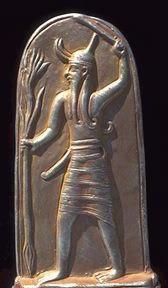
21- The Sacred Lion Hunt(Per. An. III)
While in Egypt, Hadrian left Alexandria accompanied by his inner circle to hunt a man-eating lion that had terrorized the countryside of the Libyan desert. Pancrates wrote an epic poem detailing the last known event in the life of Antinous, the hunt in which Antinous was nearly killed. The strength and skill of Hadrian, saved him from death. His failure to kill the Lion, and narrow escape are a reminder of the human weakness of Antinous, but the courage that he displayed against a beast far more powerful than he is a sign of his distain for life, and of his defiance of the great spirit that rules the world. Hadrian killed the Lion to show that only the Living King of the Gods could overcome such power, the Cosmocrater had defeated himself, for Antinous, so that Antinous would find godliness when the time had come.
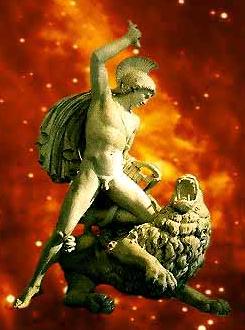
21- The Miracle of the Red Lotus
When the Lion was killed, the red lotus flower called Antinoeios, miraculously sprouted from the blood and sand and was offered to Antinous as a trophy. This miracle was the first emblem of the religion of Antinous. The blossoming of Antinoeios symbolizes the Love and Grace of Antinous, and the strength of the Lion that had become the power of Antinous. The red lotus flower, Antinoeios , is the symbol of Belief in Antinous.

21- The Sacred Games (Every Fourth Year)
After the Foundation of Antinous, Hadrian inaugurated Sacred Games in honor of the new God Antinous. They were repeated every four years in Antinoopolis, Bythinum, and Mantineia. It is believed that the first of these took place in Antinoopolis in the year 131, as Hadrian and the Imperial court returned from their visit up the Nile to the ancient city of Thebes. Antinoopolis was under construction, and it is believed that the process of mummification and Apotheosis of Antinous had been completed by the early spring. After the Greek custom, athletic competitions for Ephebes (boys in late adolescence and early manhood, 17-22 years old) including footraces, horse races, chariot races, javelin and discus throwing, jumping, boxing, swimming, and boat rowing in the Nile were all part of the ceremonies. But in addition to these, it is believed that art, music, theater, and poetry were also part of the competition. The winner was awarded citizenship in Antinoopolis and public monetary support. It is also believed that the champion was crowned as the living incarnation of Antinous and worshipped as the Divine Ephebe. The emblem of championship was the wreath of red lotus flowers called Antinoeios. The next Antinoead will be in 2014.

SEPTEMBER
6- Antinous in Athens (Per. An. I)
Antinous and Hadrian stayed in Athens from September 128, through February 129. Their time was spent among philosophers and artists. Athens was Hadrian's favorite city in the Empire, and the time spent here with Antinous was perhaps the high point of their lives together. This day is revered as the occasion in which the virtues of the Academy of Plato, and pleasures of the Garden of Epicurus took their place in the heart of Antinous. It was here also that Antinous attended sacred theater of Dionysus. We venerate Athena, the goddess of wisdom, as the guardian and guide of Hadrian, and as the Sophia of learning, the Lady of Philosophers.
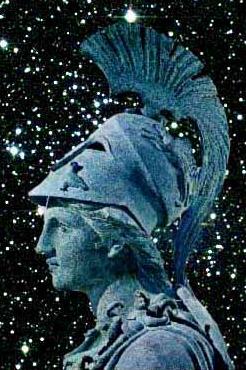
19- The Birth of Antoninus Pius
T. Aurelius Fulvius Boionius Arrius Antoninus was born on this day 86 A.D. at Lanuvium, near Rome. Under Hadrian he served as Proconsul of Asia minor from 130 to 135, the most crucial years in the development of the religion of Antinous. After that he was summoned to Rome to be close to Hadrian as his health failed. After the death of Aelius Caesar, Hadrian chose Antoninus to be his successor in 138. During his reign between the years 140-144, Antoninus issued coins celebrating the religious glory of Rome in celebration of the nine hundredth anniversary of the city in 147. The coins asserted the superiority of Romanism over the Empire. Antoninus is said to have restored the sanctity of the ancient Roman faith, and to have reinvigorated its ceremonies, which is another possible reason why he was surnamed Pius.
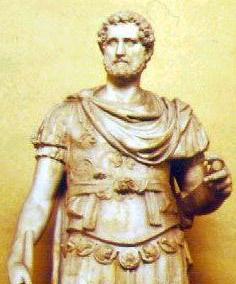
21- The Mysteries of Eleusis (Per. An. I)
While in Athens in 128, it is known that the Imperial court attended the celebration of the Mysteries of Eleusis, and therefore it is believed that Antinous underwent the first level of initiation. Hadrian was one of only two emperors initiated into the Mysteries. The Story of the abduction of Persephone can only have had a deep impression on the sensitive heart of Antinous, and set in motion the events of his deification. Persephone, the Queen of the Dead, is the mother of Antinous, the divine child, just as she is the mother of Dionysus, she is also his divine twin, with whose consent Antinous is able to resurrect and obtain immortality. The mysteries of Eleusis conferred salvation upon the soul of all who partook in their celebration. Without witnessing the ceremonies, without the knowing that they transferred, the soul was doomed to oblivion and dispersal.

21- Antinous on Mount Cassius (Per. An. II)
The court ascends Mount Cassius in Syria on top of which is a Temple of the Sun. A storm breaks while they make their ascent, and Hadrian has the priests conduct the ceremony in the rain. During the sacrifice at the altar, lighting strikes, killing the priest and the sacrificial animal together. This is taken as a very significant portent, one that Antinous alone comprehends, the darkness of the coming death and transfiguration are presaged. Hadrian takes it as a sign that the gods of Syria have turned against him, it is Baal-Zeus who strikes the priests down as a warning to Hadrian of what lies ahead when the court enters Jerusalem. We pray for the mercy of the gods, that they will turn their face upon us in blessing and take away their anger from our lives.
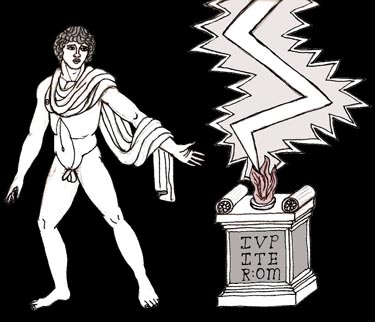
21- The Blessing of St. Carpocrates (Per. An. III)
The Gnostic Father St. Carpocrates was in Alexandrian when the Imperial court arrived. His doctrine of Freedom and Libertinism came to flower shortly after the death and deification of Antinous. St. Carpocrates taught that we were all equal to the gods, but that we do not remember our divine origin. The process of self-deification involves exposing ourselves to the angels who ruled over forbidden things so as to be free from their control. Homosexuality was considered sacred by Carpocrates because it is a form of love fundamentally free from the process of regeneration. St. Carpocrates possessed a copy of the Secret Gospel of Mark, which contained a passage from the life of Jesus in which the Savior reveals the Kingdom of Heaven to a boy by laying naked with him. While in Alexandria, we believe that Antinous blessed and inspired the young Carpocrates to spread his new philosophy to the world. We observe this moment of transfiguration as the mutual consecration exchanged by Antinous the God and Carpocrates the Gnostic, while Hadrian's entourage boarded the fleet of ships and departed from Alexandria. Carpocrates blessed the Sacred Boat as Antinous stepped aboard. The profundity of the Carpocratian message is the heart of the Salvation of Antinous.
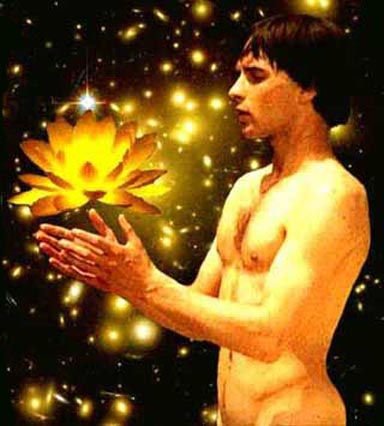
21- The Sacred Ship of Antinous (Per. An. III)
The Imperial entourage set sail in a fleet of gilded ships that would carry them up the Sacred Nile. The inundated waters were beginning to recede making the journey possible, as it was forbidden for the King to travel on the river while it was still in flood. Antinous and Hadrian assumed their places on the sacred boat from which later, Antinous would take his plunge into godliness. This Ship is what we call the Boat of Millions of Years, a symbol for our religion, and an illustration of the ever-lasting Heaven of Antinous, which is a journey across the river of the Milky Way, toward the Black Star.
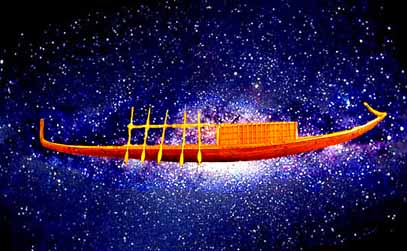
25- Antinous in Heliopolis (Per. An. III)
The first important stop on the Nile journey was at Heliopolis, the ancient center of the worship of Re, the sun god. The Heliopolitan cosmology stated that the universe was created when the Atum (first principle) masturbated and created himself as the sun god Re, the visible manifestation of the Atum and then rose up from the primordial waters in the form of a mound.. Re then proceeded to give birth to the Enneads, the Nine beings who created the world. They were Shu (air) and Tefnut (fire), Geb (Earth), Nut (Sky), and Osiris and Isis, Seth and Nepthys who together were the principles of life. The creator, Re-Harakhte, traveled across the sky on his Boat of Millions of Years every day, and then as it submerged beneath the horizon, Re-Harakhte battled against death and evil, and was greeted triumphantly each moring by the priests of Heliopolis. Antinous was admitted into these mysteries, and partook gained a place by the side of Re-Harakhte on his sacred boat as evidenced by the Obelisk.

OCTOBER
1- The Orphic Mysteries (Per. An. I)
The cult of Orpheus was centered in Athens, having intimate connection to the Mysteries of Eleusis. Antinous and Hadrian, while in Athens would have met with the remnants of the ancient cult, which was still in practice, and had become largely integrated by the Platonists at the Academy. Orpheus was the son of Apollo and the muse Calliope, and from his father he received the Lyre and the gift of music. So powerful was the music of Orpheus that he could tame the hearts of beasts and birds and his song enchanted even the trees and stones. He was one of the Argonauts who together with Jason, retrieved the Golden Fleece. Returning from the journey, he married Euridice, but the marriage was short-lived because while fleeing the Shepard Aristeus, who was attempting to rape her, she was bitten by a snake hidden in the grass and died. Orpheus was so overwhelmed with grief that he used his powers of enchantment to travel to the underworld to bring back his wife. His music soothed the three-headed dog, and gained his entry into the dark hall of Hades and Persephone. There he sang to the rulers of the underworld, and his song touched the cold heart of the Lady of Death. Persephone decreed that he could lead his wife out of hell provided that he did not turn to see her following. Orpheus singing as he went, very nearly succeeded, but at the last moment, at the very gate of darkness, he turned and saw his wife vanish back into oblivion. From that moment Orpheus was a changed man, he became a priest of Dionysus, and gave himself over to intoxication, completely shunning the company of women, and separating himself from the customs of the world. Orpheus is said to have been the first to sanctify homosexuality as an indulgence that frees the soul from continued reincarnation through the procreation of the flesh. His journey through the underworld gave him a deep detestation of death that he developed into a new philosophy. Orpheus taught that we were all children of the fallen star Dionysus-Zagreus, who had been torn to pieces by the Titans and consumed by them so that his light was mingled throughout their flesh. Zeus struck the Titans down with his lighting and from their ashes arose mankind, fashioned by Prometheus. So that we will never suffer the fate of passing into the realm of Hades, Orpheus taught that we must restrain our titanic nature and restore the purity of our godliness, we must become Bachkoi, which is that we must become Dionysus again. A pure life, free from murder, including blood sacrifice and the eating of meat is required, and that we undergo initiation into the blessed rites which he inaugurated. Though part of the religion of Dionysus, the Orphic cult was limited to men. Orpheus wrote volumes of sacred poems that comprised the heart of his new religion. The Orphic cult was a combination of the freedom and indulgence of Dionysus, tempered with the high-minded nobility of Apollo. The Orphics denied the world and set their minds on the inner light of Dionysus so as to liberate the soul from imprisonment within the flesh. On this day, the beginning of the holy month of the Sacred Nights of Antinous, we venerate Orpheus. Antinous our god was initiated into the cult of Orpheus so that his teachings became part of the religion of Antinous, and therefore we receive the salvation that Orpheus accomplished through our god Antinous, the New Dionysus.
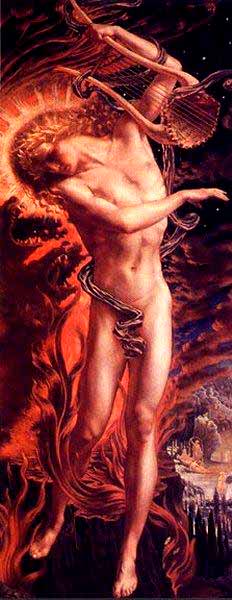
5- Antinous in Baalbek (Per. An. II)
The city of Baalbek, also know to the Greeks as Heliopolis, was visited by Hadrian and Antinous in the fall of 129 CE, while the court was still based in Antioch. Ancient legend said that Baal was born here, known as the "Valley of the City of the Sun." During the Hellenistic age, following the conquest of Alexander, the old religion of Baal slowly gave way to that of Zeus-Jupiter, and a new god was created who the Romans called Jupiter Heliopolitan. Astarte was likewise assimilated with Venus, and Adonis was worshipped as Dionysus. Together these three made up the triad of Baalbek-Helipolis, and some of the largest Temples in the Roman Empire were built here. Some of the foundation stones of the Temple of Jupiter measure over 1000 tons and are a scientific mystery of megalithic construction. The city of Baalbek-Heliopolis was an immensely important sacred site, with highly erotic, religious, solar significance. But it is these gigantic stones that are our spiritual focus, because it is in this season that we prepare ourselves to be as living stones in the Temple of Antinous. Antinous and Hadrian, always interested in architecture would have been shown the miraculous stones, would have touched them and stood amazed by their size. Let us direct our attention to the image above which shows a man inspecting the mysterious foundation stones, and let this be a metaphor for the immensity of our task as the Stones of the Temple of Antinous.
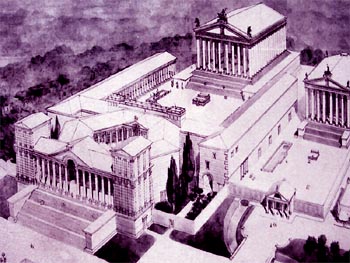
5- Antinous in Memphis (Per. An. III)
Hadrian and Antinous arrived in splendor at Memphis the ancient capital of the Old Kingdom. The Memphite cosmology held that the god Ptah was the creator of the universe, that out of fire he created Atum and the Ennead of the Heliopolis. Ptah created the Atum from his burning heart and speech, and then the Atum created the world with his hands and semen. In later days Ptah would become a ruler of the underworld, or more specifically, of what lied beyond these world, he was the root of the root. He was accompanied two other goddess, Sekhmet-Bast, the Lion-Cat Goddess who represents destruction and Nefertum, their son, whose name means "the accomplisher of Atum" and represents preservation and healing. Antinous was exposed to these mysteries that brought him deeper into the unfolding of the nature of the universe and the identity of the first principle. He was initiated into the double nature of creation, through Sekhmet and Nefertum. Pictured at right are is the Memphite triad with a very white-skinned king who resembles Antinous.
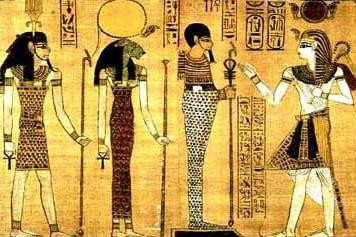
7- St. Sergius and St. Bacchus
The patron saints of homosexuality in the Christian religion are St. Sergius and St. Bacchus. They were inseparable officers in the Roman army stationed in Syria during the reign of Emperor Maximian who was fond of them and honored them repeatedly, which gave rise to jealousy in the court. A rival denounced Sergius and Bacchus, accusing them of not venerating the ancient gods of Rome, and of being Christians. When summoned to sacrifice to the genius of the Emperor, as was the Roman custom, Sergius and Bacchus refused. They were imprisoned and subjected to a long series of tortures aimed at forcing them to sacrifice to the gods. They were stripped of and made to walk through the streets wearing the clothing of women, a strange form of humiliation not usually inflicted on Christians, but a sign that their sexuality was being used to mock the saints. Bacchus was beaten to death, but Sergius proved to be considerably stronger than any torture that the Pagans could subject him to. When he was on the verge of surrender, and in despair, the spirit of Bacchus appeared to him and said:
"Why do you grieve and mourn, brother? If I have been taken from you in body, I am still with you in the bond of union…Hurry then, yourself, through beautiful and perfect confession to pursue and obtain me."
Sergius was so strengthened that he could not be compelled to betray his faith, and the pagans chopped off his head. For their strength and for the valor of their love for one another, and because for so many centuries they have remained the champions of homosexual love and devotion. We honor the Christian Saints Sergius and Bacchus as saints of the Religion of Antinous.
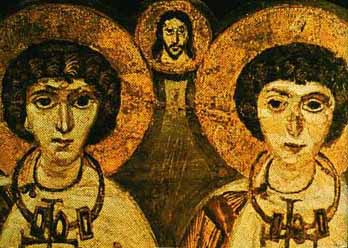
11- National Coming Out Day
This international event is in celebration of the joy of revealing to the world our sexuality. It is an internationally event that gives people the opportunity to come out as an act of spiritual and political courage, in defiance of all who would deny homosexuals our human rights. The first National Coming Out Day was held on October 11, 1988, it was in commemoration for the 1987 March on Washington. In its full essence it is a political statement, meant to call out to our brothers and sisters to publicly state that they are homosexual to all those who do not already know. We acknowledge the spiritual implication of this event as profoundly significant to the religion of Antinous and of the mysterious nature of Homo Deus. As an act of Liberation and as a vision promotion of our presence and numbers, we solemnly dedicate ourselves to public declaration of our sacred sexuality on this day.
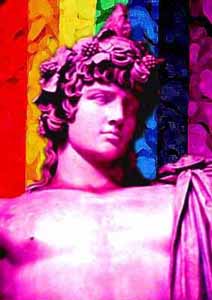
11- Antinous in Oxyrhynchus (Per. An. III)
Antinous entered the city of Oxyrhynchus, a Greek city founded by the Ptolemies, that has since become famous for the thousands of papyrus fragments unearthed in its buried libraries. The people of Oxyrhynchus were highly literate and therefore made a welcome stop for the Greek-loving emperor Hadrian. The visit of Antinous to this city is important because several fragments mention his name, and the sacred poem of the Lion Hunt was found here. We are reminded by Oxyrhynchus of the fragile nature of the written word and how easily knowledge can be lost, and therefore, we sanctify the memory of the city to the importance that these fragments confer about our God Antinous. The Goddess of Oxyrhynchus is Athena-Sophia, patroness of learning.

12- The Martyrdom of St. Matthew Shepard
Matthew Shepard died at 12:53 am on Monday, October 12th, 1998. He was brutally assaulted because he was gay, on the night of October 7 by two men who had lured him to a secluded place outside of Laramie Wyoming. His attackers tied him to a fence, beat him and left him for dead in the freezing cold. He was found the following evening by a cyclist. By the time help arrived, he had slipped into unconsciousness. The death of Matthew Shepard awakened the world to the persecution that homosexuals have endured for centuries. His beauty, youth and innocence affected everyone, and spoke for the hundreds of others who in recent years have died similar deaths without being noticed. Matthew Shepard is a Sacred and Holy Martyr of Homosexuality, he died an innocent because he was gay. He died a death that so many others have suffered, but his death changed the world. He was 22 years old, very near the age of Antinous, and like Antinous, his beautiful face, humble origin, and tragic death have had a great impact on the future of homosexuality in our society. We consecrate his memory and pray for him, that he will guide and protect us in our hour of danger, and bring an end to the violence and hatred that he suffered.

13- The Condemnation of the Order of Knights Templar
The proud and courageous brotherhood known as the Order of Knights Templar, who were sworn to protect pilgrims traveling to the Holy Land, were accused of Heresy, Idolatry and Sodomy, and were arrested on Friday the 13th, 1310 in France. Although they had fought valiantly during the Crusades, and even stayed behind, sacrificing themselves to guard the retreat of Christian refugees during the fall of Acre in 1291, the order was condemned by the Pope and handed over to the jealous King Philip the "Fair" of France, who coveted their land and immense wealth. The Knights had adopted the heresy of Catharism which was basically a form of Gnosticism with Manichean influence, that had perhaps been introduced to them in the Holy Land where it flourished under the Moslems. The Cathars believed that Jesus had descended to undo the rule of the God of Israel, and that he had liberated mankind from the law of Moses and the natural order, through salvation in his name. The Cathars believed that the body, and life itself was the creation of the Evil One, who claimed to be the Creator of the Universe. They did not recognize the authority of the Church and believed that homosexuality was sacred because it was a form of love that did not result in procreation. Following the Platonic ideal of Venus Urania, the Cathars believed that Brotherly Love was more in keeping Christ's teaching than the love between husband and wife. The Knights Templar, whose seal depicted two knights riding on one horse, quite openly advocated this philosophy, but the accusation claimed that they took this to the extreme of sodomy, requiring new initiates to perform the Kiss of Shame, where they kissed the buttocks and phallus of the Grand Master of the Order. They were also accused of abandoning Christianity and worshipping a demon called Baphomet, a hermaphroditic, goat-headed idol whose name implied secret knowledge. Other accusations were leveled against the Knights, but Heresy, Satanism, and Sodomy were the crimes that essentially led to their downfall. Of course most of this information was obtained through torture, but one can only wonder at the consistency that characterizes their confessions. On this night, the Grand Master Jacques de Molay and thousands of Templars were arrested, tortured, condemned and subsequently Burned at the Stake. From then on, Heresy, Devil worship, and Homosexuality were indistinguishable in the eyes of the Inquisition, perhaps because they were indeed interconnected. Homosexuality however had not been a significant threat to Christendom until it was connected with a diabolical plot to overthrow the order of society and of the Church. This was the beginning of Our Burning Times, and over the course of the next four hundred years, thousands of homosexuals were officially and publicly condemned and burned or otherwise executed as an act of faith that through our extermination, the Church was protecting the world from the forces of Evil which we embodied. For their courage and sacrifice, we praise the Order of the Knights Templar as Heroic Martyr Saints of Ecclesia Antinoi, as the Sacred Band of the Middle Ages, and we recognize their secret god Baphomet as an incarnation of our beloved Dionysus, a manifestation of Homo Deus, and of Our Beautiful God Antinous.
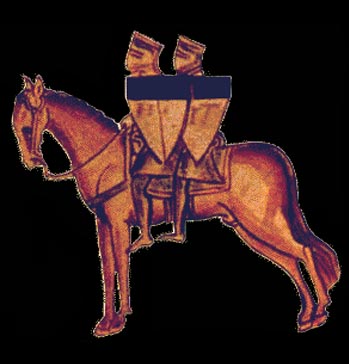
22- Antinous in Hermopolis (Per. An. III)
The Ancient city of Hermopolis was the center of the religion of Thoth, the ibis-headed the scribe god, which held a cosmology that is believed to have been much older than those of other Egyptian cities. It was said that Thoth laid an egg in the void from which emerged eight beings in the form of frogs and snakes, who together are called the Ogdoad, and are the creators of the universe. Their names are Naun and Naunet (initial waters-inertia) Heh and Hehet (spatial infinity) Kek and Keket (darkness) and Amun and Amunet (That which is hidden.) The Ogdoad created a lotus flower which rose up from the primordial waters and when the lotus blossomed, the god Re was born. Re then proceeded to bring order to the universe, which is where the other cosmologies are concerned. The Greeks called Hermopolis "The City of Hermes" because they identified Hermes with Thoth, and from this union was born the mystical religion called Hermeticism whose patron deity was the teacher of knowledge known as Hermes Trismegistus. Hermopolis was the last city that Antinous ever saw. He was present during the festival of the Passion of Osiris, and was mystically consecrated to become Osiris. We celebrate the visitation of Antinous to Hermopolis as the moment in which our religion became infused with the mysteries of Hermes Trismegistus.
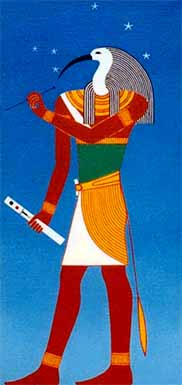
24- St. Harry Hay
The founder of the modern Gay Movement, Harry Hay was born in England in 1912, but soon moved to Los Angeles where he spent most of his life. He discovered his sexuality early in life and dropped out of college to work as an actor. Politically active throughout his life, he was heavily involved with the communist party, and 1950 he founded the Mattachine Society, the first gay political organization in the United States. It was a secret society based on Masonic principals that took its name from a troupe of medieval dancers who performed with masks over their faces. Harry Hay, however, proved to be far too extreme for the society and was expelled. He spent the next two decades as a political, anti-war activist, and was profoundly moved and involved in the emergence of gay liberation after the Stonewall Riot. In 1979, Harry Hay co-founded the Radial Faeries, a gay spiritual organization that has lasted the test of time and has spread across the country. The central philosophy of the Radical Fairies is that gay men are fundamentally different and that the difference is a spiritual blessing to be celebrated, and used to spread tolerance and love in the world. St. Harry Hay died in San Francisco on October 24 2002, on the first day of the first Sacred Nights observed by Ecclesia Antinoi. We ask his blessing in our endeavor and the guidance of his immortal spirit on our quest for the sanctity of homosexuality.

24- The Passion of Osiris
Antinous and the Imperial entourage were in the ancient city of Hermopolis during the celebration of the Death and Resurrection of Osiris. It is believed that the forces of this occasion, and the mysteries divulged to him by the Hermetic priests of the god Thoth, were the inspiration for this ascension into godliness. The story is that Isis returned from Phoenicia with the sarcophagus containing the body of Osiris. With the assistance of Thoth, she brought life back into the dead body, and hovering over the body in the form of a bird, she became impregnated with Horus who would avenge his father. Set, however discovered that the body of Osiris had returned to Egypt and together with seventy-two accomplices, he attacked it and torn in into pieces, scattering the fragments up and down the valley of the Nile, like the seeds that are scattered over the fields when the Nile recedes. The festival of Osiris celebrated at Hermopolis and observed by Hadrian and Antinous commemorated the rending of the body of Osiris and the searching of Isis for each of the parts. Like Osiris, Antinous descended into the Nile, and arose to bring the blessing of eternal life to the world. The religion of Antinous, like the body of Osiris was scattered over the face of the world, and we who worship him, are like Isis, gathering the fragments together again. Hermopolis was the last city that Antinous ever saw, and the Passion of Osiris was the last religious ceremony in which he took part. Certainly it here and at this time that an awakening occurred, dark in its implications, causing Antinous to relinquish his life, but it was of splendid power in that from the death of the boy, a god emerged. We observe that in Hermopolis, the scattering of the body of Osiris was the moment when the sperm of the blessed one was planted in the immortal spirit of Antinous, Our God.

SACRED NIGHTS OF ANTINOUS
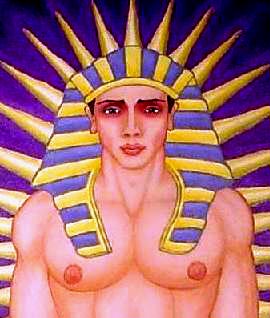
28- The Death of Antinous
Near the village of Hir-wer, Antinous fell into the Nile and drowned. There are those who believe that he willingly gave himself to prolong the life of his beloved Hadrian, or that his death was suicidal, that he was murdered, or that it was merely an accident, but there is no way to know, no way to be certain. Hadrian who perhaps knew more than anyone else, simple said that he fell. We priests of Ecclesia Antinoi do not take a definite position on any of the posibilities and leave the matter as an unknowable mystery. The manner in which Antinous died is not of first importance, only the effect that his death had upon the world. On this day, we solemnly and silently mourn the Death of Antinous whom Hadrian loved and for whom he wept, and we sorrow for the loss of such great beauty at so young an age. We pray for the Bithynian boy who died so far from home. With his death, our religion was set in motion. We lament and exalt in the grief of Hadrian that was so strong and so powerful that it spread to the whole face of the world, and affects us still today. We pray also for all those homosexuals who have died in youth as a consequence of repression, we mourn the suicides, and commit them to the soothing arms of Antinous, who was assumed into the Nile for all of us.
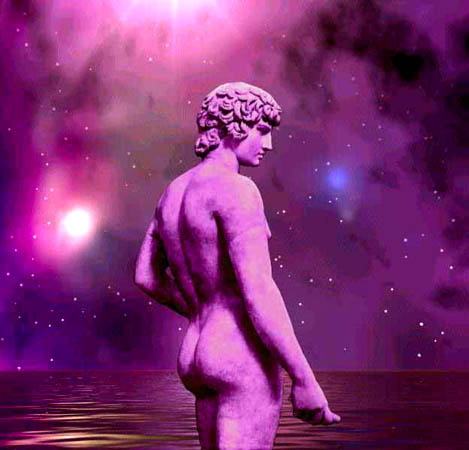
29- The Descent into the Underworld
Antinous is embraced by Osiris beneath the water of the Holy Nile, and he is given over to Hermes-Anubis and led into the underworld. He appears before the Lords of the scale of Maat, but his spirit is divine and the scales crumble at his touch. Hermes-Anubis escorts Antinous into the Hall of the Queen of the Dead, Persephone, and because he is a witness of the Mysteries of Eleusis, he obtains from her the pomegranate of immortality. The immortal spirit of Antinous does not taste death, and he is given to drink of the fountain that restores memory because he has learned from Orpheus that he is from the Earth but is a Child of the Stars. Antinous conquers death and returns from darkness. At midnight Antinous the God arises from the Nile and steps onto the shore from which he fell. The spirits of the entourage of Dionysus attend his resurrection and he is reborn as the New Osiris-Dionysus. This is the last day of the Ecclesiastic Year, it is spent in darkness and in solemn devotion as Antinous journeys through the underworld, we confront the weakness of being without our god, we reflect on the passage of the year, and on the influence of Antinous upon our lives, and we pray for the triumph of his return. At midnight, a pure candle is ignighted to symbolize the deification of Antinous Our God.
